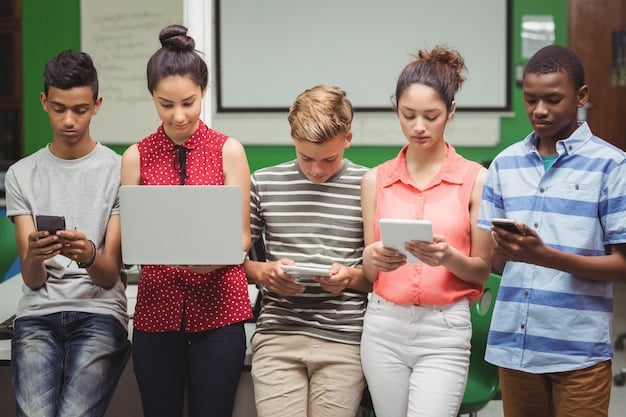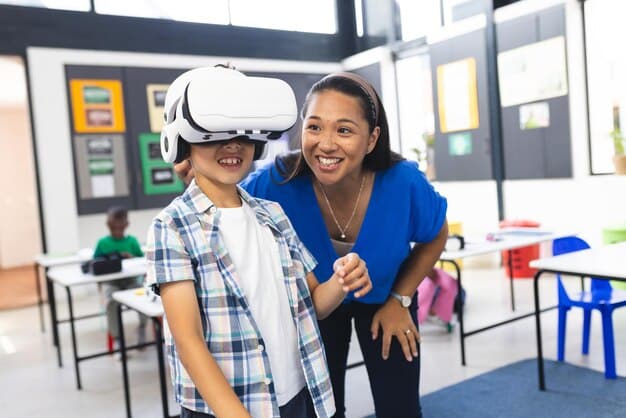The Future of Education: Technology’s Impact on US Schools

The Future of Education: How Technology is Transforming Learning in US Schools involves integrating digital tools to personalize learning, enhance engagement, and prepare students for a tech-driven world, reshaping traditional educational models.
The educational landscape in the United States is undergoing a profound shift. As we look to the future of education: how technology is transforming learning in US schools, it’s clear that digital innovations are no longer just supplementary aids but are becoming integral components of the learning process.
From personalized learning platforms to virtual reality field trips, the integration of technology has the potential to revolutionize how students learn, how teachers teach, and how schools operate. This transformation promises to create more engaging, accessible, and effective learning environments for all students in the U.S.
Exploring the Digital Revolution in US Education
The integration of technology into US schools isn’t merely about replacing textbooks with tablets. It’s a comprehensive transformation that touches every aspect of education, from curriculum design to assessment methods. This shift is driven by the recognition that today’s students are digital natives, accustomed to interacting with technology in their daily lives.
Personalized Learning Paths
Technology enables educators to create personalized learning paths tailored to individual student needs and learning styles. Adaptive learning platforms analyze student performance and adjust the difficulty level of content in real-time, ensuring that each student is challenged appropriately.
Enhanced Engagement
Interactive simulations, educational games, and multimedia resources can make learning more engaging and enjoyable for students. These tools capture students’ attention and foster a deeper understanding of complex concepts. The future of education lies in captivating learners through these advanced methods.
- Increased Motivation: Gamified learning environments boost student motivation and encourage active participation.
- Deeper Understanding: Interactive simulations allow students to explore concepts in a hands-on, immersive way.
- Real-World Relevance: Technology connects learning to real-world applications, making education more relevant and meaningful.

Ultimately, the digital revolution in education aims to create a learning environment that is more responsive, engaging, and effective for all students. The adaptability of technology ensures that education can evolve alongside the changing needs of students and society. By embracing these advancements, US schools can prepare students for success in the 21st century workforce and beyond, marking a key step in the future of education: how technology is transforming learning in US schools.
The Role of Technology in Bridging Educational Gaps
One of the most promising aspects of technology in education is its potential to bridge educational gaps and promote equity. Access to quality education remains a significant challenge for many students, particularly those from low-income backgrounds or rural communities. Technology can help to level the playing field by providing access to resources and opportunities that would otherwise be unavailable.
Expanding Access to Resources
Online learning platforms and digital libraries provide students with access to a vast array of educational resources, regardless of their geographic location or socioeconomic status. These resources can supplement traditional classroom instruction and provide students with additional support and enrichment opportunities.
Supporting Students with Disabilities
Assistive technologies, such as screen readers, speech-to-text software, and alternative input devices, can help students with disabilities access and participate in the learning process. These tools remove barriers to learning and enable all students to reach their full potential.
Technology can play a crucial role in creating a more equitable and inclusive education system for all students in the U.S. By leveraging the power of digital tools, educators can ensure that every student has the opportunity to succeed. This inclusivity is a vital component of the future of education: how technology is transforming learning in US schools.
The Future of Education: How Technology is Transforming Learning in US Schools
The future of education: how technology is transforming learning in US schools is not just a trend, but a fundamental shift in how we approach teaching and learning. Technology is enabling educators to deliver more personalized, engaging, and effective instruction, while also providing students with the skills and knowledge they need to succeed in a rapidly changing world.
Developing 21st Century Skills
One of the key goals of education is to prepare students for success in the workforce. Technology can help students develop essential 21st century skills, such as critical thinking, problem-solving, collaboration, and communication. These skills are highly valued by employers and are essential for success in today’s global economy.
Preparing Students for a Tech-Driven World
Technology is transforming every aspect of our lives, and the education system must adapt to prepare students for this reality. By integrating technology into the curriculum, schools can help students develop digital literacy skills and prepare them for careers in STEM fields and other tech-related industries. This preparation is pivotal in the future of education: how technology is transforming learning in US schools.
- Digital Literacy: Understanding how to use technology effectively and responsibly.
- Coding and Programming: Developing skills in computer science and software development.
- Data Analysis: Learning how to collect, analyze, and interpret data.

In essence, the future of education: how technology is transforming learning in US schools is about empowering students with the skills and knowledge they need to thrive in a digital world. By embracing technology, educators can create learning experiences that are both relevant and engaging, preparing students for success in college, careers, and beyond.
Addressing the Challenges of Technology Integration
While the potential benefits of technology in education are significant, there are also challenges that must be addressed. These challenges include issues of access, equity, and teacher training.
Ensuring Equitable Access
Not all students have access to the technology they need to succeed. Many low-income students lack access to computers and internet at home, creating a digital divide. Schools must work to ensure that all students have equitable access to technology, regardless of their socioeconomic status. The solution is a vital part of the future of education: how technology is transforming learning in US schools.
Providing Adequate Teacher Training
Teachers need adequate training and support to effectively integrate technology into their instruction. Professional development programs can help teachers learn how to use technology to enhance their teaching and create engaging learning experiences for their students.
Overcoming these challenges is essential for realizing the full potential of technology in education. By addressing issues of access, equity, and teacher training, schools can ensure that all students benefit from the digital revolution. This comprehensive approach is paramount in ensuring the future of education: how technology is transforming learning in US schools benefits everyone.
The Impact of AI and Machine Learning on Education
Artificial intelligence (AI) and machine learning are poised to have a profound impact on the future of education. These technologies can personalize learning, automate administrative tasks, and provide valuable insights into student performance.
AI-Powered Tutoring Systems
AI-powered tutoring systems can provide students with personalized feedback and support, adapting to their individual learning needs. These systems can identify areas where students are struggling and provide targeted interventions to help them improve.
Automated Assessment and Grading
AI can automate many of the time-consuming tasks associated with assessment and grading, freeing up teachers to focus on instruction and student support. AI-powered grading systems can provide accurate and consistent feedback, helping students to identify areas for improvement.
The impact of AI and machine learning on education is just beginning to be felt. As these technologies continue to evolve, they have the potential to transform the way we teach and learn, offering unprecedented opportunities for personalization and innovation. Through AI, the future of education: how technology is transforming learning in US schools becomes more intelligent and adaptive.
Looking Ahead: Envisioning the Future of Tech-Enabled Education
The future of education is undoubtedly intertwined with technology. As we move forward, it is important to envision how technology can be used to create a more effective, equitable, and engaging education system for all students in the U.S.
Focus on Innovation
Schools and educators need to embrace innovation and be willing to experiment with new technologies and teaching methods. By fostering a culture of innovation, we can create learning environments that are dynamic, responsive, and relevant to the needs of today’s students.
Continuous Professional Development
Ongoing professional development is essential for teachers to stay up-to-date with the latest technologies and best practices. Schools should invest in professional development programs that provide teachers with the skills and knowledge they need to effectively integrate technology into their instruction. This ongoing support is crucial to the future of education: how technology is transforming learning in US schools.
| Key Aspect | Brief Description |
|---|---|
| 💻 Tech Integration | Digital tools are now crucial for personalized learning. |
| 🌐 Bridging Gaps | Tech helps equalize access to resources for all students. |
| 🤖 AI & Learning | AI personalizes tutoring and automates grading tasks. |
Frequently Asked Questions
Technology transforms teachers into facilitators, guiding personalized learning experiences rather than delivering traditional lectures. They focus on critical thinking and collaboration, leveraging digital tools to enhance student engagement.
The primary benefits include personalized learning paths, increased student engagement, improved access to resources, and the development of essential 21st-century skills, preparing them for a tech-driven world.
It addresses equity by providing access to online resources, assistive technologies, and personalized learning, regardless of socioeconomic status or geographic location, aiming to level the playing field.
Students are expected to develop digital literacy, critical thinking, problem-solving, collaboration, and communication skills, all vital for success in contemporary workplaces and higher education.
AI personalizes tutoring, automates assessment, and provides insights into student performance, enabling teachers to tailor instruction and support students more effectively, leading to improved outcomes.
Conclusion
As we conclude, the future of education: how technology is transforming learning in US schools is not merely an aspiration but a rapidly evolving reality. The integration of digital tools, AI, and innovative teaching methods holds immense promise for creating a more effective, equitable, and engaging education system.
By embracing these changes, addressing the inherent challenges, and prioritizing equitable access, US schools can prepare students to thrive in an increasingly tech-driven world. The journey towards a transformed education system requires collaboration, innovation, and a steadfast commitment to empowering all learners.





